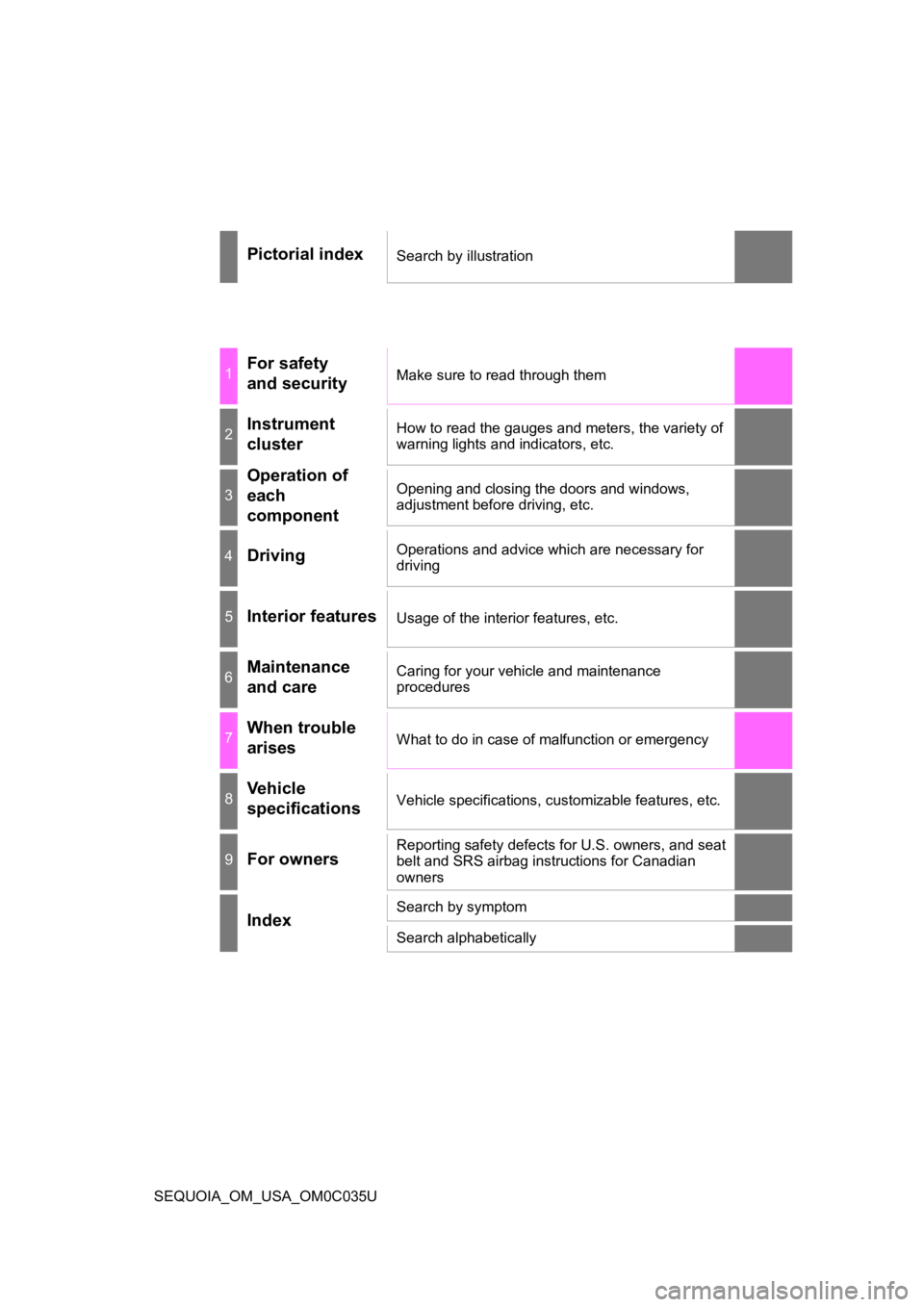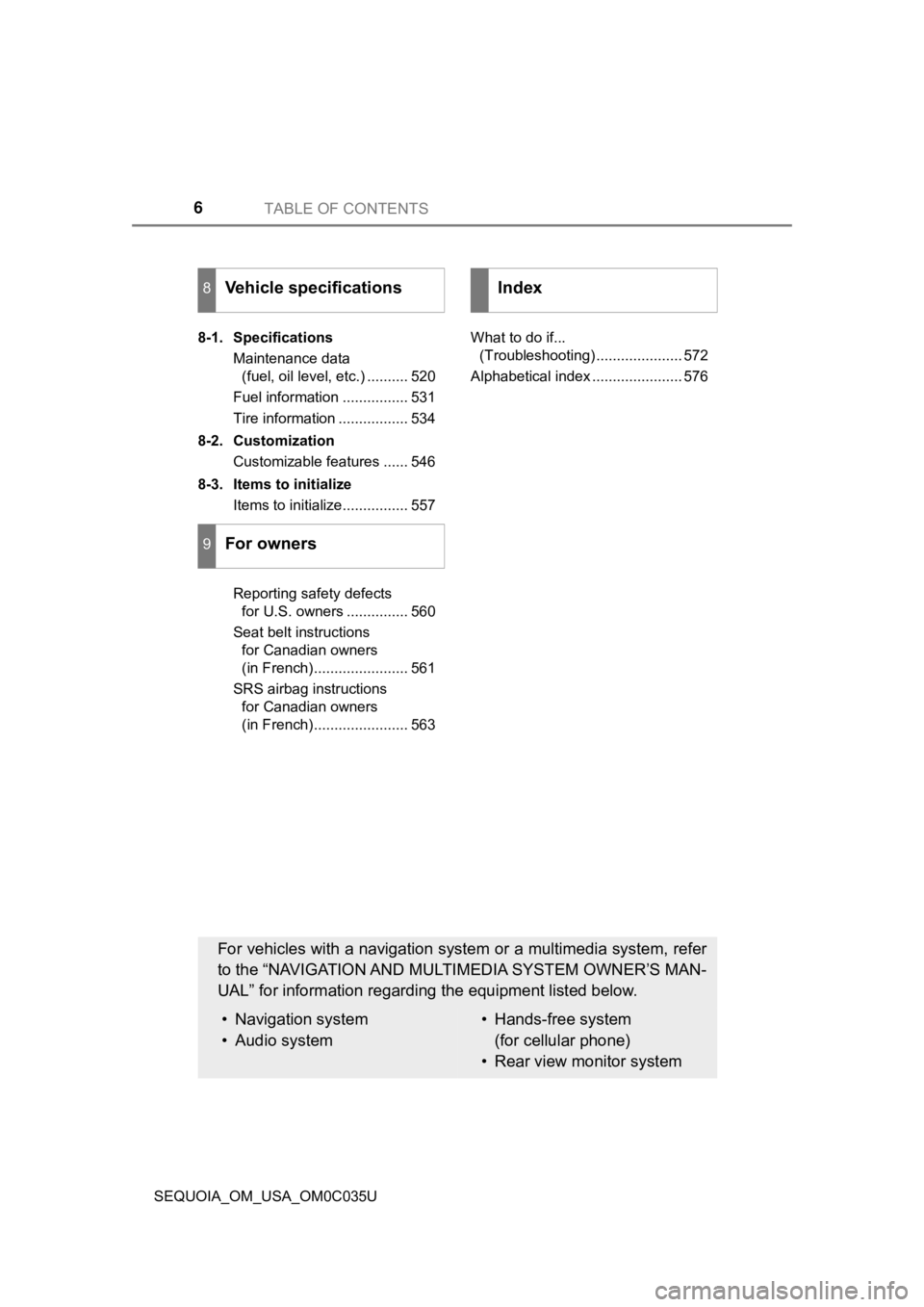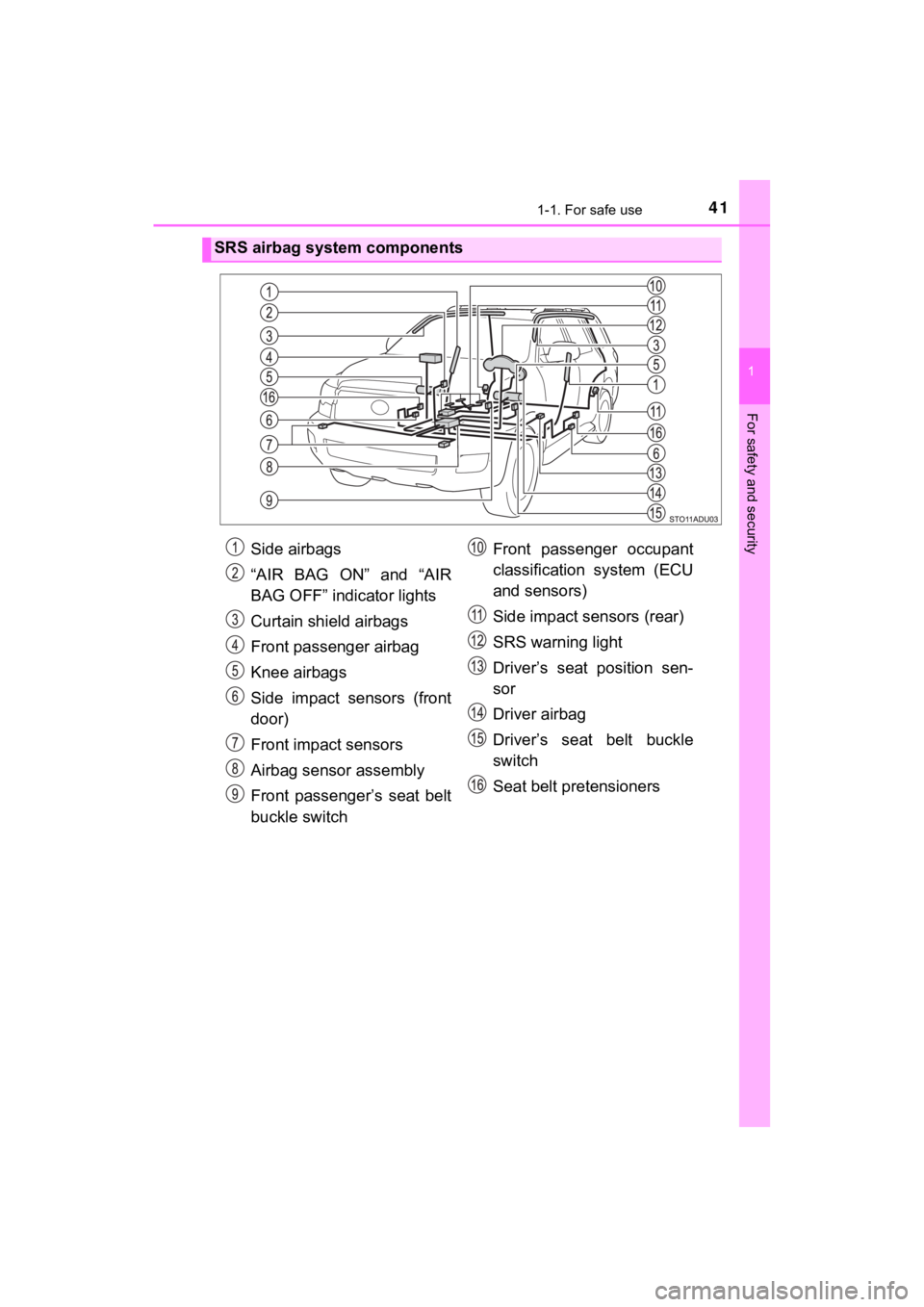airbag TOYOTA SEQUOIA 2021 Owners Manual (in English)
[x] Cancel search | Manufacturer: TOYOTA, Model Year: 2021, Model line: SEQUOIA, Model: TOYOTA SEQUOIA 2021Pages: 588, PDF Size: 12.76 MB
Page 1 of 588

SEQUOIA_OM_USA_OM0C035U
Pictorial indexSearch by illustration
1For safety
and securityMake sure to read through them
2Instrument
clusterHow to read the gauges and meters, the variety of
warning lights and indicators, etc.
3
Operation of
each
componentOpening and closing the doors and windows,
adjustment before driving, etc.
4DrivingOperations and advice which are necessary for
driving
5Interior featuresUsage of the interior features, etc.
6Maintenance
and careCaring for your vehicle and maintenance
procedures
7When trouble
arisesWhat to do in case of malfunction or emergency
8Vehicle
specificationsVehicle specifications, customizable features, etc.
9For ownersReporting safety defects for U.S. owners, and seat
belt and SRS airbag instructions for Canadian
owners
IndexSearch by symptom
Search alphabetically
Page 2 of 588

TABLE OF CONTENTS2
SEQUOIA_OM_USA_OM0C035UFor your information....................... 8
Reading this manual .................... 14
How to search .............................. 15
Pictorial index .............................. 16
1-1. For safe use
Before driving ...................... 26
For safe driving ................... 28
Seat belts ............................ 30
SRS airbags ........................ 40
Front passenger occupant classification system ......... 51
Safety information for children ............................. 57
Child restraint systems ........ 58
Installing child restraints ...... 62
Exhaust gas precautions ..... 75
1-2. Emergency assistance Safety Connect.................... 76
1-3. Theft deterrent system Engine immobilizer system............................... 82
Alarm ................................... 84
2. Instrument cluster Warning lights and indicators........................... 88
Gauges and meters............. 94
Multi-information display ..... 98
Fuel consumption information ...................... 104 3-1. Key information
Keys................................... 108
3-2. Opening, closing and locking the doors
Side doors ......................... 113
Back door .......................... 118
Smart key system .............. 128
3-3. Adjusting the seats Front seats......................... 136
Rear seats ......................... 138
Driving position memory .... 149
Head restraints .................. 154
3-4. Adjusting the steering wheel and mirrors
Steering wheel ................... 156
Inside rear view mirror ....... 158
Outside rear view mirrors ............................. 161
3-5. Opening, closing the windows and
moon roof
Power windows.................. 165
Power back window ........... 168
Moon roof .......................... 171
1For safety and security
2Instrument cluster
3Operation of
each component
Page 6 of 588

TABLE OF CONTENTS6
SEQUOIA_OM_USA_OM0C035U8-1. Specifications
Maintenance data (fuel, oil level, etc.) .......... 520
Fuel information ................ 531
Tire information ................. 534
8-2. Customization Customizable features ...... 546
8-3. Items to initialize Items to initialize................ 557
Reporting safety defects for U.S. owners ............... 560
Seat belt instructions for Canadian owners
(in French)....................... 561
SRS airbag instructions for Canadian owners
(in French)....................... 563 What to do if...
(Troubleshooting) ..................... 572
Alphabetical index ...................... 576
8Vehicle specifications
9For owners
Index
For vehicles with a navigation s ystem or a multimedia system, r efer
to the “NAVIGATION AND MULTIMEDIA SYSTEM OWNER’S MAN-
UAL” for information regarding the equipment listed below.
• Navigation system
• Audio system• Hands-free system
(for cellular phone)
• Rear view monitor system
Page 9 of 588

9
SEQUOIA_OM_USA_OM0C035UThe installation of a mobile two-way radio system in your vehic
le could affect
electronic systems such as:
● Multiport fuel injection system/sequential multiport fuel injection system
● Toyota Safety Sense P
● Dynamic radar cruise control system
● Anti-lock brake system
● SRS airbag system
● Seat belt pretensioner system
Be sure to check with your Toyota dealer for precautionary meas ures or spe-
cial instructions regarding instal lation of a mobile two-way radio system.
The vehicle is equipped with sophisticated computers that will record certain
data, such as:
• Engine speed / Electric motor speed (traction motor speed)
• Accelerator status
• Brake status
• Vehicle speed
• Operation status of the driving assist systems
• Images from the front camera (available only when certain safe ty sys-
tems are activated, which varies depending on the vehicle specifica-
tions).
The recorded data varies according to the vehicle grade level and options
with which it is equipped.
These computers do not record conversations or sounds, and only record
images outside of the vehicle in certain situations.
●Data Transmission
Your vehicle may transmit the data recorded in these computers to Toyota
without notification to you.
Installation of a mobile two-way radio system
Vehicle data recording
Page 12 of 588

12
SEQUOIA_OM_USA_OM0C035UThe SRS airbag and seat belt pretensioner devices in your Toyot
a contain
explosive chemicals. If the vehicle is scrapped with the airbag s and seat belt
pretensioners left as they are, this may cause an accident such as fire. Be
sure to have the systems of the SRS airbag and seat belt preten sioner
removed and disposed of by a qualified service shop or by your Toyota dealer
before you scrap your vehicle.
Special handling may apply,
See www.dtsc.ca.gov/hazardouswaste/perchlorate.
Your vehicle has components that may contain perchlorate. These compo-
nents may include airbag, seat belt pretensioners, and wireless remote con-
trol batteries.
Scrapping of your Toyota
Perchlorate Material
WARNING
■ General precautions while driving
Driving under the influence: Never drive your vehicle when unde r the influ-
ence of alcohol or drugs that have impaired your ability to operate your vehi-
cle. Alcohol and certain drugs delay reaction time, impair judg ment and
reduce coordination, which could lead to an accident that could result in
death or serious injury.
Defensive driving: Always drive defensively. Anticipate mistake s that other
drivers or pedestrians might make and be ready to avoid acciden ts.
Driver distraction: Always give your full attention to driving. Anything that
distracts the driver, such as adjusting controls, talking on a cellular phone or
reading can result in a collision with resulting death or serio us injury to you,
your occupants or others.
■ General precaution regar ding children’s safety
Never leave children unattended in the vehicle, and never allow children to
have or use the key.
Children may be able to start the vehicle or shift the vehicle into neutral.
There is also a danger that children may injure themselves by p laying with
the windows, the moon roof, or other features of the vehicle. In addition,
heat build-up or extremely cold temperatures inside the vehicle can be fatal
to children.
Page 23 of 588

23Pictorial index
SEQUOIA_OM_USA_OM0C035U
■Interior
SRS airbags . . . . . . . . . . . . . . . . . . . . . . . . . . . . . . . . . . . . . . . P. 40
Floor mat . . . . . . . . . . . . . . . . . . . . . . . . . . . . . . . . . . . . . . . . . P. 26
Front seats . . . . . . . . . . . . . . . . . . . . . . . . . . . . . . . . . . . . . . . P. 136
Rear seats . . . . . . . . . . . . . . . . . . . . . . . . . . . . . . . . . . . . . . . . P. 138
Head restraints . . . . . . . . . . . . . . . . . . . . . . . . . . . . . . . . . . . . P. 154
Seat belts . . . . . . . . . . . . . . . . . . . . . . . . . . . . . . . . . . . . . . . . . P. 30
Console box . . . . . . . . . . . . . . . . . . . . . . . . . . . . . . . . . . P. 361, 363
Inside lock buttons . . . . . . . . . . . . . . . . . . . . . . . . . . . . . . . . P. 115
Cup holders . . . . . . . . . . . . . . . . . . . . . . . . . . . . . . . . . . . . . . P. 366
Bottle holders . . . . . . . . . . . . . . . . . . . . . . . . . . . . . . . . . . . . . P. 369
Page 25 of 588

25
For safety and security1
SEQUOIA_OM_USA_OM0C035U1-1. For safe use
Before driving ...................... 26
For safe driving ................... 28
Seat belts ............................ 30
SRS airbags ........................ 40
Front passenger occupant classification system ......... 51
Safety information for children ............................. 57
Child restraint systems........ 58
Installing child restraints...... 62
Exhaust gas precautions..... 75
1-2. Emergency assistance Safety Connect ................... 76
1-3. Theft deterrent system Engine immobilizer system .............................. 82
Alarm................................... 84
Page 40 of 588

401-1. For safe use
SEQUOIA_OM_USA_OM0C035U
SRS airbags
◆SRS front airbagsSRS driver airbag/front passenger airbag
Can help protect the head and c hest of the driver and front pas-
senger from impact with interior components
SRS knee airbags
Can help provide driver and front passenger protection
◆SRS side and curta in shield airbags
SRS side airbags
Can help protect the torso o f the front seat occupants
SRS curtain sh ield airbags
● Can help protect primarily the head of occupants in the outer
seats
● Can help prevent the occupants from being thrown from the
vehicle in the event of vehicle rollover
The SRS airbags inflate when th e vehicle is subjected to certain
types of severe impacts that may cause significant injury to th e
occupants. They work together wit h the seat belts to help reduce
the risk of death or serious injury.
Page 41 of 588

411-1. For safe use
1
For safety and security
SEQUOIA_OM_USA_OM0C035U
SRS airbag system components
Side airbags
“AIR BAG ON” and “AIR
BAG OFF” indicator lights
Curtain shield airbags
Front passenger airbag
Knee airbags
Side impact sensors (front
door)
Front impact sensors
Airbag sensor assembly
Front passenger’s seat belt
buckle switchFront passenger occupant
classification system (ECU
and sensors)
Side impact sensors (rear)
SRS warning light
Driver’s seat position sen-
sor
Driver airbag
Driver’s seat belt buckle
switch
Seat belt pretensioners
Page 42 of 588

421-1. For safe use
SEQUOIA_OM_USA_OM0C035U
Your vehicle is equipped with ADVANCED AIRBAGS designed based
on the US motor vehicle safety standards (FMVSS208). The airbag
sensor assembly (ECU) controls airbag deployment based on infor-
mation obtained from the sensors etc. shown in the system compo -
nents diagram above. This informat ion includes crash severity and
occupant information. As the airbags deploy, a chemical reactio n in
the inflators quickly fills the airbags with non-toxic gas to h elp restrain
the motion of t he occupants.
WARNING
■SRS airbag precautions
Observe the following precautions regarding the SRS airbags.
Failure to do so may cause death or serious injury.
● The driver and all passengers in the vehicle must wear their se at belts
properly.
The SRS airbags are supplemental devices to be used with the se at belts.
● The SRS driver airbag deploys with considerable force, and can cause
death or serious injury especially if the driver is very close to the airbag.
The National Highway Traffic Safety Administration (NHTSA) advi ses:
Since the risk zone for the driver’s airbag is the first 2 - 3 in. (50 - 75 mm)
of inflation, placing yourself 10 in. (250 mm) from your driver airbag pro-
vides you with a clear margin of safety. This distance is measured from
the center of the steering wheel to your breastbone. If you sit less than
10 in. (250 mm) away now, you can change your driving position i n sev-
eral ways:
• Move your seat to the rear as far as you can while still reach ing the ped-
als comfortably.
• Slightly recline the back of the seat.
Although vehicle designs vary, many drivers can achieve the 10 in.
(250 mm) distance, even with the driver seat all the way forward , simply
by reclining the back of the seat somewhat. If reclining the ba ck of your
seat makes it hard to see the road, raise yourself by using a f irm, non-
slippery cushion, or raise the seat if your vehicle has that feature.
• If your steering wheel is adjustable, tilt it downward. This points the air-
bag toward your chest instead of your head and neck.
The seat should be adjusted as recommended by NHTSA above, whil e
still maintaining control of the foot pedals, steering wheel, and your view
of the instrument panel controls.